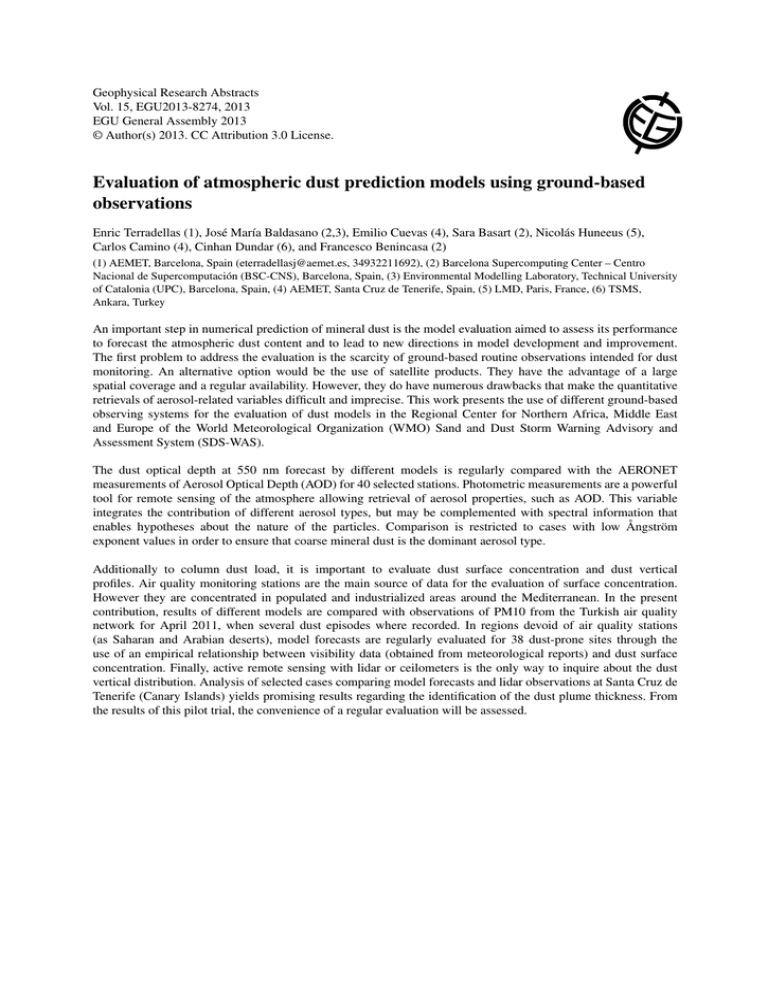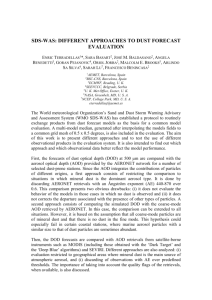Evaluation of atmospheric dust prediction models using ground
advertisement

Geophysical Research Abstracts Vol. 15, EGU2013-8274, 2013 EGU General Assembly 2013 © Author(s) 2013. CC Attribution 3.0 License. Evaluation of atmospheric dust prediction models using ground-based observations Enric Terradellas (1), José María Baldasano (2,3), Emilio Cuevas (4), Sara Basart (2), Nicolás Huneeus (5), Carlos Camino (4), Cinhan Dundar (6), and Francesco Benincasa (2) (1) AEMET, Barcelona, Spain (eterradellasj@aemet.es, 34932211692), (2) Barcelona Supercomputing Center – Centro Nacional de Supercomputación (BSC-CNS), Barcelona, Spain, (3) Environmental Modelling Laboratory, Technical University of Catalonia (UPC), Barcelona, Spain, (4) AEMET, Santa Cruz de Tenerife, Spain, (5) LMD, Paris, France, (6) TSMS, Ankara, Turkey An important step in numerical prediction of mineral dust is the model evaluation aimed to assess its performance to forecast the atmospheric dust content and to lead to new directions in model development and improvement. The first problem to address the evaluation is the scarcity of ground-based routine observations intended for dust monitoring. An alternative option would be the use of satellite products. They have the advantage of a large spatial coverage and a regular availability. However, they do have numerous drawbacks that make the quantitative retrievals of aerosol-related variables difficult and imprecise. This work presents the use of different ground-based observing systems for the evaluation of dust models in the Regional Center for Northern Africa, Middle East and Europe of the World Meteorological Organization (WMO) Sand and Dust Storm Warning Advisory and Assessment System (SDS-WAS). The dust optical depth at 550 nm forecast by different models is regularly compared with the AERONET measurements of Aerosol Optical Depth (AOD) for 40 selected stations. Photometric measurements are a powerful tool for remote sensing of the atmosphere allowing retrieval of aerosol properties, such as AOD. This variable integrates the contribution of different aerosol types, but may be complemented with spectral information that enables hypotheses about the nature of the particles. Comparison is restricted to cases with low Ångström exponent values in order to ensure that coarse mineral dust is the dominant aerosol type. Additionally to column dust load, it is important to evaluate dust surface concentration and dust vertical profiles. Air quality monitoring stations are the main source of data for the evaluation of surface concentration. However they are concentrated in populated and industrialized areas around the Mediterranean. In the present contribution, results of different models are compared with observations of PM10 from the Turkish air quality network for April 2011, when several dust episodes where recorded. In regions devoid of air quality stations (as Saharan and Arabian deserts), model forecasts are regularly evaluated for 38 dust-prone sites through the use of an empirical relationship between visibility data (obtained from meteorological reports) and dust surface concentration. Finally, active remote sensing with lidar or ceilometers is the only way to inquire about the dust vertical distribution. Analysis of selected cases comparing model forecasts and lidar observations at Santa Cruz de Tenerife (Canary Islands) yields promising results regarding the identification of the dust plume thickness. From the results of this pilot trial, the convenience of a regular evaluation will be assessed.



